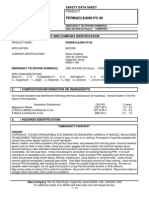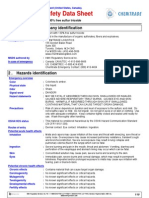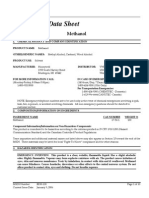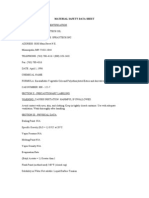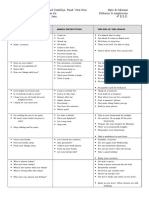NP-40 Alternative: Material Safety Data Sheet
NP-40 Alternative: Material Safety Data Sheet
Uploaded by
Ikumi MisuCopyright:
Available Formats
NP-40 Alternative: Material Safety Data Sheet
NP-40 Alternative: Material Safety Data Sheet
Uploaded by
Ikumi MisuOriginal Title
Copyright
Available Formats
Share this document
Did you find this document useful?
Is this content inappropriate?
Copyright:
Available Formats
NP-40 Alternative: Material Safety Data Sheet
NP-40 Alternative: Material Safety Data Sheet
Uploaded by
Ikumi MisuCopyright:
Available Formats
NP-40 Alternative
sc-281108
Material Safety Data Sheet
Hazard Alert Code Key:
EXTREME
HIGH
MODERATE
LOW
Section 1 - CHEMICAL PRODUCT AND COMPANY IDENTIFICATION PRODUCT NAME
NP-40 Alternative
STATEMENT OF HAZARDOUS NATURE
CONSIDERED A HAZARDOUS SUBSTANCE ACCORDING TO OSHA 29 CFR 1910.1200.
NFPA
FLAMMABILITY
HEALTH HAZARD
INSTABILITY
SUPPLIER
Santa Cruz Biotechnology, Inc. 2145 Delaware Avenue Santa Cruz, California 95060 800.457.3801 or 831.457.3800 EMERGENCY ChemWatch Within the US & Canada: 877-715-9305 Outside the US & Canada: +800 2436 2255 (1-800-CHEMCALL) or call +613 9573 3112
SYNONYMS
(C2H4O)nC15H24O, "Teric N2, N2, N3, N4, N5, N8, N8U, N9, N10, N11, N12, N13, N15, N20, N30, ", "N40, N40L, N100", "Teric GN5, GN8, GN10, GN11, GN12, GN13, GN15", "Tergitol N series NPX TP-9 NP-14 NP-27 NP-33 NP-35", "Lissapol NX", "Pannox 9A6", "Synperonic NX", "nonylphenyl ethoxylate", "nonylphenol ether", polyoxyethylene, "ethoxylated alcohols", "polyethanoxy 9", "nonyl phenol", "nonionic surfactant", "nonyl phenol ethylene oxide condensate", "nonylphenol ethoxylate", "alpha-(nonylphenyl)-w-hydroxypoly(oxy-1, 2-ethanediyl)", "alpha-(nonylphenyl)-omega-hydroxy-poly(oxy-1, 2-ethanediyl)", nonylphenoxypolyethoxyethanol, "polyoxyethylated p-nonylphenol", "poly(oxy-1, 2-ethanediyl), alpha-(4-nonylphenyl)-omega-hydroxy-", "Nonoxinol 9", "Liponox NCI", "Sigma 74385", "Nonidet P40 Substitute", "Non-Ionic Surfactant #4", "Univar Nizhex", "NPE 10", "NPE 9", "Neonol AF 9-8", "AF 6-6", "10 9 8 6 mol"
Section 2 - HAZARDS IDENTIFICATION CHEMWATCH HAZARD RATINGS
Min Flammability Toxicity Body Contact Reactivity 1 2 3 1
Min/Nil=0 Low=1 Moderate=2 High=3 Extreme=4
Max
1 of 8
Chronic
CANADIAN WHMIS SYMBOLS
CANADIAN WHMIS CLASSIFICATION
CAS 9016-45-9,26027-38-3Nonylphenol ethoxylate D2B-Toxic Material Causing Other Toxic Effects
EMERGENCY OVERVIEW RISK
Harmful if swallowed. Irritating to skin. Risk of serious damage to eyes. Repeated exposure may cause skin dryness and cracking. Toxic to aquatic organisms, may cause long-term adverse effects in the aquatic environment.
POTENTIAL HEALTH EFFECTS ACUTE HEALTH EFFECTS SWALLOWED
Accidental ingestion of the material may be harmful; animal experiments indicate that ingestion of less than 150 gram may be fatal or may produce serious damage to the health of the individual. Nonionic surfactants may produce localised irritation of the oral or gastrointestinal lining and induce vomiting and mild diarrhoea.
EYE
If applied to the eyes, this material causes severe eye damage. Non-ionic surfactants can cause numbing of the cornea, which masks discomfort normally caused by other agents and leads to corneal injury. Irritation varies depending on the duration of contact, the nature and concentration of the surfactant.
SKIN
The material may cause mild but significant inflammation of the skin either following direct contact or after a delay of some time. Repeated exposure can cause contact dermatitis which is characterised by redness, swelling and blistering. Repeated exposure may cause skin cracking, flaking or drying following normal handling and use. Open cuts, abraded or irritated skin should not be exposed to this material. Entry into the blood-stream, through, for example, cuts, abrasions or lesions, may produce systemic injury with harmful effects. Examine the skin prior to the use of the material and ensure that any external damage is suitably protected.
INHALED
The material is not thought to produce either adverse health effects or irritation of the respiratory tract following inhalation (as classified by EC Directives using animal models). Nevertheless, adverse systemic effects have been produced following exposure of animals by at least one other route and good hygiene practice requires that exposure be kept to a minimum and that suitable control measures be used in an occupational setting.
CHRONIC HEALTH EFFECTS
Prolonged or repeated skin contact may cause drying with cracking, irritation and possible dermatitis following. Substance accumulation, in the human body, may occur and may cause some concern following repeated or long-term occupational exposure. Based on experience with similar materials, there is a possibility that exposure to the material may reduce fertility in humans at levels which do not cause other toxic effects. Prolonged or repeated skin contact may cause degreasing with drying, cracking and dermatitis following. Exposure to alkyl phenolics is associated with reduced sperm count andfertility in males.
Section 3 - COMPOSITION / INFORMATION ON INGREDIENTS NAME nonylphenol, ethoxylated CAS RN 9016-45-9 % 100
Section 4 - FIRST AID MEASURES SWALLOWED
2 of 8
IF SWALLOWED, REFER FOR MEDICAL ATTENTION, WHERE POSSIBLE, WITHOUT DELAY. For advice, contact a Poisons Information Centre or a doctor. Urgent hospital treatment is likely to be needed. In the mean time, qualified first-aid personnel should treat the patient following observation and employing supportive measures as indicated by the patient's condition.
EYE
If this product comes in contact with the eyes Immediately hold eyelids apart and flush the eye continuously with running water. Ensure complete irrigation of the eye by keeping eyelids apart and away from eye and moving the eyelids by occasionally lifting the upper and lower lids. Continue flushing until advised to stop by the Poisons Information Centre or a doctor, or for at least 15 minutes. Transport to hospital or doctor without delay.
SKIN
If skin contact occurs Immediately remove all contaminated clothing, including footwear. Flush skin and hair with running water (and soap if available). Seek medical attention in event of irritation.
INHALED
If fumes, aerosols or combustion products are inhaled remove from contaminated area. Other measures are usually unnecessary.
NOTES TO PHYSICIAN
for poisons (where specific treatment regime is absent) -------------------------------------------------------------BASIC TREATMENT -------------------------------------------------------------Establish a patent airway with suction where necessary. Watch for signs of respiratory insufficiency and assist ventilation as necessary. Administer oxygen by non-rebreather mask at 10 to 15 L/min. Monitor and treat, where necessary, for pulmonary oedema . Treat symptomatically.
Section 5 - FIRE FIGHTING MEASURES
Vapour Pressure (mmHG) Upper Explosive Limit (%) Specific Gravity (water=1) Lower Explosive Limit (%) < 0.001 Not available 1.04 approx. Not available
EXTINGUISHING MEDIA Water spray or fog. Foam. Dry chemical powder. BCF (where regulations permit). FIRE FIGHTING Alert Fire Brigade and tell them location and nature of hazard. Wear full body protective clothing with breathing apparatus. Prevent, by any means available, spillage from entering drains or water course. Use water delivered as a fine spray to control fire and cool adjacent area. When any large container (including road and rail tankers) is involved in a fire, consider evacuation by 100 metres in all directions. GENERAL FIRE HAZARDS/HAZARDOUS COMBUSTIBLE PRODUCTS Combustible. Slight fire hazard when exposed to heat or flame. Heating may cause expansion or decomposition leading to violent rupture of containers. On combustion, may emit toxic fumes of carbon monoxide (CO). Combustion products include carbon dioxide (CO2), other pyrolysis products typical of burning organic material. FIRE INCOMPATIBILITY Avoid contamination with oxidising agents i.e. nitrates, oxidising acids, chlorine bleaches, pool chlorine etc. as ignition may result
Section 6 - ACCIDENTAL RELEASE MEASURES
MINOR SPILLS
3 of 8
Environmental hazard - contain spillage. Slippery when spilt. Clean up all spills immediately. Avoid breathing vapours and contact with skin and eyes. Control personal contact by using protective equipment. Contain and absorb spill with sand, earth, inert material or vermiculite. MAJOR SPILLS Environmental hazard - contain spillage. Slippery when spilt. Moderate hazard. Clear area of personnel and move upwind. Alert Fire Brigade and tell them location and nature of hazard. Wear breathing apparatus plus protective gloves. Prevent, by any means available, spillage from entering drains or water course.
Section 7 - HANDLING AND STORAGE PROCEDURE FOR HANDLING
DO NOT allow clothing wet with material to stay in contact with skin Overheating of ethoxylates in air should be avoided. When some ethoxylates are heated vigorously in the presence of air or oxygen, at temperatures exceeding 160 C, they may undergo exothermic oxidative degeneration resulting in self-heating and autoignition. Nitrogen blanketing will minimise the potential for ethoxylate oxidation. Trace quantities of ethylene oxide may be present in the material. Although these may accumulate in the headspace of storage and transport vessels, concentrations are not expected to exceed levels which might produce a flammability or worker exposure hazard. Avoid all personal contact, including inhalation. Wear protective clothing when risk of exposure occurs. Use in a well-ventilated area. Prevent concentration in hollows and sumps.
RECOMMENDED STORAGE METHODS
Metal can or drum Packaging as recommended by manufacturer. Check all containers are clearly labelled and free from leaks.
STORAGE REQUIREMENTS
Store in original containers. Keep containers securely sealed. Store in a cool, dry, well-ventilated area. Store away from incompatible materials and foodstuff containers.
Section 8 - EXPOSURE CONTROLS / PERSONAL PROTECTION EXPOSURE CONTROLS PERSONAL PROTECTION
RESPIRATOR
Type A-P Filter of sufficient capacity. (AS/NZS 1716 & 1715, EN 1432000 & 1492001, ANSI Z88 or national equivalent)
EYE
Safety glasses with side shields. Chemical goggles. Contact lenses may pose a special hazard; soft contact lenses may absorb and concentrate irritants. A written policy document, describing the wearing of lens or restrictions on use, should be created for each workplace or task. This should include a review of lens absorption and adsorption for the class of chemicals in use and an account of injury experience. Medical and first-aid personnel should be trained in their removal and suitable equipment should be readily available. In the event of chemical exposure, begin eye irrigation immediately and remove contact lens as soon as practicable. Lens should be removed at the first signs of eye redness or irritation - lens should be removed in a clean environment only after workers have washed hands thoroughly. [CDC NIOSH Current
4 of 8
Intelligence Bulletin 59], [AS/NZS 1336 or national equivalent]
HANDS/FEET
Wear chemical protective gloves, eg. PVC. Wear safety footwear or safety gumboots, eg. Rubber Suitability and durability of glove type is dependent on usage. Important factors in the selection of gloves include frequency and duration of contact, chemical resistance of glove material, glove thickness and dexterity
OTHER
Overalls. P.V.C. apron. Barrier cream. Skin cleansing cream.
ENGINEERING CONTROLS
Engineering controls are used to remove a hazard or place a barrier between the worker and the hazard. Well-designed engineering controls can be highly effective in protecting workers and will typically be independent of worker interactions to provide this high level of protection. The basic types of engineering controls are Process controls which involve changing the way a job activity or process is done to reduce the risk. Enclosure and/or isolation of emission source which keeps a selected hazard "physically" away from the worker and ventilation that strategically "adds" and "removes" air in the work environment.
Section 9 - PHYSICAL AND CHEMICAL PROPERTIES PHYSICAL PROPERTIES
Liquid. Mixes with water.
State Melting Range (F) Boiling Range (F) Flash Point (F) Decomposition Temp (F) Autoignition Temp (F) Upper Explosive Limit (%) Lower Explosive Limit (%) Volatile Component (%vol) APPEARANCE
Liquid 68- 75 Not available 536- 554 Not available Not available Not available Not available Not available
Molecular Weight Viscosity Solubility in water (g/L) pH (1% solution) pH (as supplied) Vapour Pressure (mmHG) Specific Gravity (water=1) Relative Vapour Density (air=1) Evaporation Rate
Not applicable Not available Miscible 6-8 Not applicable < 0.001 1.04 approx. Not available Not available
Actual physical properties depend on degree of ethoxylation. Appearance can be liquid, paste, solid or flakes with colour in the melted form being clear, colourless to straw. Most mix with water but the lower ethoxylates of the series being dispersible only. None are biodegradable.
Section 10 - CHEMICAL STABILITY CONDITIONS CONTRIBUTING TO INSTABILITY
Presence of incompatible materials. Product is considered stable. Hazardous polymerisation will not occur.
STORAGE INCOMPATIBILITY
Phenols are incompatible with strong reducing substances such as hydrides, nitrides, alkali metals, and sulfides. Avoid use of aluminium, copper and brass alloys in storage and process equipment. Heat is generated by the acid-base reaction between phenols and bases. Phenols are sulfonated very readily (for example, by concentrated sulfuric acid at room temperature), these reactions generate heat. Avoid reaction with oxidising agents For incompatible materials - refer to Section 7 - Handling and Storage.
5 of 8
Section 11 - TOXICOLOGICAL INFORMATION
nonylphenol, ethoxylated
TOXICITY AND IRRITATION
Both laboratory and animal testing has shown that there is no evidence for alcohol ethoxylates (AEs) causing genetic damage, mutations or cancer. No adverse reproductive or developmental effects were observed. Animal testing showed that at levels of greater than 100mg/kg, effects were limited to changes in organ weights, with no pathological changes except for liver hypertrophy. AEs are not contact sensitisers. Neat AE are irritating to eyes and skin. The irritation potential of aqueous solutions of AEs depends on concentration. Spray cleaner aerosols and laundry powder detergent dust discharge so little airborne AE that there is unlikely to be irritation of the respiratory tract. In summary, the human health risk assessment has demonstrated that the use of AE in household laundry and cleaning detergents is safe and does not cause concern with regard to consumer use. The material may produce severe irritation to the eye causing pronounced inflammation. Repeated or prolonged exposure to irritants may produce conjunctivitis. The material may cause skin irritation after prolonged or repeated exposure and may produce on contact skin redness, swelling, the production of vesicles, scaling and thickening of the skin.
CARCINOGEN nonylphenol, ethoxylated US - Maine Chemicals of High Concern List Carcinogen
Section 12 - ECOLOGICAL INFORMATION
Toxic to aquatic organisms, may cause long-term adverse effects in the aquatic environment. This material and its container must be disposed of as hazardous waste. Avoid release to the environment. Refer to special instructions/ safety data sheets.
Ecotoxicity
Ingredient nonylphenol, ethoxylated Persistence: Water/Soil LOW Persistence: Air No Data Available Bioaccumulation LOW Mobility MED
GESAMP/EHS COMPOSITE LIST - GESAMP Hazard Profiles
Name / EHS Cas No / RTECS No _______ ___ __ Alkaryl 197 4 polyeth er (C9C20) (LOA) / CAS:901 6- 459/ TRN A1a A1b A1 A2 B1 B2 C1 C2 C3 D1 D2 D3 E1 E2 E3
___ 90
___ 4
___
___ 4
___ NR
___ 3
___ NI
___ 0
___ 0
___ (3)
___ 2
___ 3
___
___
___ S
___ 2
Legend: EHS=EHS Number (EHS=GESAMP Working Group on the Evaluation of the Hazards of Harmful Substances Carried by Ships) NRT=Net Register Tonnage, A1a=Bioaccumulation log Pow, A1b=Bioaccumulation BCF, A1=Bioaccumulation, A2=Biodegradation, B1=Acuteaquatic toxicity LC/ECIC50 (mg/l), B2=Chronic aquatic toxicity NOEC (mg/l), C1=Acute mammalian oral toxicity LD50 (mg/kg), C2=Acutemammalian dermal toxicity LD50 (mg/kg), C3=Acute mammalian inhalation toxicity LC50 (mg/kg), D1=Skin irritation & corrosion, D2=Eye irritation& corrosion, D3=Long-term health effects, E1=Tainting, E2=Physical effects on wildlife & benthic habitats, E3=Interference with coastal amenities, For column A2: R=Readily biodegradable, NR=Not readily biodegradable. For column D3: C=Carcinogen, M=Mutagenic, R=Reprotoxic, S=Sensitising, A=Aspiration hazard, T=Target organ systemic toxicity, L=Lunginjury, N=Neurotoxic, I=Immunotoxic. For column E1: NT=Not tainting (tested), T=Tainting test positive. For column E2: Fp=Persistent floater, F=Floater, S=Sinking substances. The numerical scales start from 0 (no hazard), while higher numbers reflect increasing hazard. (GESAMP/EHS Composite List of Hazard Profiles - Hazard evaluation of substances transported by ships)
Section 13 - DISPOSAL CONSIDERATIONS Disposal Instructions
All waste must be handled in accordance with local, state and federal regulations.
6 of 8
Containers may still present a chemical hazard/ danger when empty. Return to supplier for reuse/ recycling if possible. Otherwise: If container can not be cleaned sufficiently well to ensure that residuals do not remain or if the container cannot be used to store the same product, then puncture containers, to prevent re-use, and bury at an authorised landfill. Where possible retain label warnings and MSDS and observe all notices pertaining to the product. Legislation addressing waste disposal requirements may differ by country, state and/ or territory. Each user must refer to laws operating in their area. In some areas, certain wastes must be tracked. A Hierarchy of Controls seems to be common - the user should investigate: Reduction Reuse Recycling Disposal (if all else fails) This material may be recycled if unused, or if it has not been contaminated so as to make it unsuitable for its intended use. If it has been contaminated, it may be possible to reclaim the product by filtration, distillation or some other means. Shelf life considerations should also be applied in making decisions of this type. Note that properties of a material may change in use, and recycling or reuse may not always be appropriate. DO NOT allow wash water from cleaning or process equipment to enter drains. It may be necessary to collect all wash water for treatment before disposal. In all cases disposal to sewer may be subject to local laws and regulations and these should be considered first. Where in doubt contact the responsible authority. Recycle wherever possible or consult manufacturer for recycling options. Consult State Land Waste Authority for disposal. Bury or incinerate residue at an approved site. Recycle containers if possible, or dispose of in an authorised landfill.
Section 14 - TRANSPORTATION INFORMATION
DOT: Symbols: Identification Numbers: Label Codes: Packaging: Exceptions: Packaging: Exceptions: G UN3082 9 155 155 Hazard class or Division: PG: Special provisions: Packaging: Non-bulk: Quantity limitations: Passenger aircraft/rail: Vessel stowage: Location: 9 III 8, 146, 335, IB3, T4, TP1, TP29 203 No limit A
Quantity Limitations: Cargo No limit aircraft only: Vessel stowage: Other: Air Transport IATA: ICAO/IATA Class: UN/ID Number: Special provisions: Cargo Only Packing Instructions: Passenger and Cargo Packing Instructions: 964 964 9 3082 A97 None
Hazardous materials descriptions and proper shipping names: Environmentally hazardous substance, liquid, n.o.s
ICAO/IATA Subrisk: Packing Group:
None III
Maximum Qty/Pack: Passenger and Cargo Maximum Qty/Pack:
450 L 450 L
7 of 8
Passenger and Cargo Limited Quantity Packing Instructions: Maritime Transport IMDG: IMDG Class: UN Number: EMS Number: Limited Quantities: 9 3082 F-A,S-F 5L Y964
Passenger and Cargo Limited Quantity Maximum Qty/Pack: 30 kg G
Shipping name:ENVIRONMENTALLY HAZARDOUS SUBSTANCE, LIQUID, N.O.S.(contains nonylphenol, ethoxylated)
IMDG Subrisk: Packing Group: Special provisions: Marine Pollutant:
None III 274 335 Yes
Shipping name:ENVIRONMENTALLY HAZARDOUS SUBSTANCE, LIQUID, N.O.S.(contains nonylphenol, ethoxylated)
Section 15 - REGULATORY INFORMATION nonylphenol, ethoxylated (CAS: 9016-45-9,26027-38-3) is found on the following regulatory lists;
"International Fragrance Association (IFRA) Survey: Transparency List","OSPAR List of Substances of Possible Concern","US Cosmetic Ingredient Review (CIR) Cosmetic ingredients found safe as used","US DOE Temporary Emergency Exposure Limits (TEELs)","US EPA High Production Volume Program Chemical List","US FMA Air Freshener Fragrance Ingredient Survey Results","US Toxic Substances Control Act (TSCA) - Chemical Substance Inventory","US TSCA Section 8 (a) - Preliminary Assessment Information Rules (PAIR) Reporting List"
Section 16 - OTHER INFORMATION LIMITED EVIDENCE
Cumulative effects may result following exposure*. May possibly affect fertility*. * (limited evidence).
Ingredients with multiple CAS Nos
Ingredient Name nonylphenol, ethoxylated CAS 9016-45-9, 26027-38-3
Classification of the preparation and its individual components has drawn on official and authoritative sources as well as independent review by the Chemwatch Classification committee using available literature references. A list of reference resources used to assist the committee may be found at: www.chemwatch.net/references. The (M)SDS is a Hazard Communication tool and should be used to assist in the Risk Assessment. Many factors determine whether the reported Hazards are Risks in the workplace or other settings.
This document is copyright. Apart from any fair dealing for the purposes of private study, research, review or criticism, as permitted under the Copyright Act, no part may be reproduced by any process without written permission from CHEMWATCH. TEL (+61 3) 9572 4700. www.Chemwatch.net
Issue Date: Dec-9-2009 Print Date:Jan-13-2012
8 of 8
You might also like
- The Health & Safety Guide for Film, TV & Theater, Second EditionFrom EverandThe Health & Safety Guide for Film, TV & Theater, Second EditionRating: 4 out of 5 stars4/5 (1)
- E-Coat Simulation STAR 2013Document35 pagesE-Coat Simulation STAR 2013Jessica Estephany Medina Salce100% (1)
- 186 Soldering Flux MSDSDocument5 pages186 Soldering Flux MSDSNicolae ChirilaNo ratings yet
- PH 208Document2 pagesPH 208William EdwardsNo ratings yet
- Safety Data Sheet: Monoethanolamine: CHEMTREC: (800) 424-9300Document9 pagesSafety Data Sheet: Monoethanolamine: CHEMTREC: (800) 424-9300Harish GojiyaNo ratings yet
- Nalco Tri Act 1820Document13 pagesNalco Tri Act 1820anon_336536469No ratings yet
- MX 416 MSDSDocument9 pagesMX 416 MSDSMunirah Hani HarunNo ratings yet
- Material Safety Data Sheet: Section 1 - Chemical Product / Company InformationDocument6 pagesMaterial Safety Data Sheet: Section 1 - Chemical Product / Company Informationceemore300No ratings yet
- MSD Eg 20Document5 pagesMSD Eg 20Julio MendezNo ratings yet
- MSDS For Crude GlycerinDocument8 pagesMSDS For Crude GlycerinGoh AiklengNo ratings yet
- Material Data Safety Sheet Jet A1 ShellDocument10 pagesMaterial Data Safety Sheet Jet A1 ShellAdnan Haji HarbiNo ratings yet
- PC 56 Biocide (Old)Document13 pagesPC 56 Biocide (Old)Hyun Jin YooNo ratings yet
- 2 Propanol OptimaDocument6 pages2 Propanol OptimaSarthak JoshiNo ratings yet
- AkzoNobel SMCA MSDS 0909 Tcm18-10237Document0 pagesAkzoNobel SMCA MSDS 0909 Tcm18-10237David HoffmanNo ratings yet
- Oleum EnglishDocument10 pagesOleum Englishhyde2520015754No ratings yet
- Potassium Nitrate MSDSDocument7 pagesPotassium Nitrate MSDStheman2160No ratings yet
- Material Safety Data Sheet Material Safety Data Sheet: TWA - Ceiling Twa - StelDocument8 pagesMaterial Safety Data Sheet Material Safety Data Sheet: TWA - Ceiling Twa - StelLâm ThanhNo ratings yet
- Methanol MSDS PDFDocument10 pagesMethanol MSDS PDFPutriErvinaNo ratings yet
- Material Safety Data Sheet: 1. Chemical Product and Company IdentificationDocument5 pagesMaterial Safety Data Sheet: 1. Chemical Product and Company IdentificationEdgar Julio Sara TairoNo ratings yet
- CNTRL Sol Acephate 75 SP MSDSDocument4 pagesCNTRL Sol Acephate 75 SP MSDSGristio PratamaNo ratings yet
- Tert-Butyl Acrylate MSDSDocument17 pagesTert-Butyl Acrylate MSDSrezaNo ratings yet
- Grotan - MSDSDocument3 pagesGrotan - MSDSjmquinonesNo ratings yet
- LEAN AMINE (Ucarsol HS 101) : B R C LDocument2 pagesLEAN AMINE (Ucarsol HS 101) : B R C Ltexwan_No ratings yet
- Nitric Acid 0 2n (n5) 24-9824 v2 1 1 1 23-Jul-2010 Us-English-local On Apr-29-2013Document9 pagesNitric Acid 0 2n (n5) 24-9824 v2 1 1 1 23-Jul-2010 Us-English-local On Apr-29-2013LucioMerloNo ratings yet
- Super Solv Remover MSDS PDFDocument3 pagesSuper Solv Remover MSDS PDFGiniNo ratings yet
- 260 GTPlus MSDSDocument10 pages260 GTPlus MSDSAlejandro Becerra CardenasNo ratings yet
- F84C-5 - Sat - MSDSDocument4 pagesF84C-5 - Sat - MSDSDenise Koh Chin HuiNo ratings yet
- Msds of Spraytech OilDocument4 pagesMsds of Spraytech OilNesscel Ann Piquero DonkDonkNo ratings yet
- M S D S: Aterial Afety ATA HeetDocument5 pagesM S D S: Aterial Afety ATA Heetmatthewnathan89No ratings yet
- MSDS TBBS Nouvel AccélérantDocument6 pagesMSDS TBBS Nouvel AccélérantJean GrégoireNo ratings yet
- Material Safety Data Sheet Ethyl AlcoholDocument8 pagesMaterial Safety Data Sheet Ethyl AlcoholApsari Puspita AiniNo ratings yet
- All Purpose Thinner Sep11Document4 pagesAll Purpose Thinner Sep11Paul De ChaufepieNo ratings yet
- MSDS Sodium NitriteDocument5 pagesMSDS Sodium NitritemarcNo ratings yet
- Methanol MSDS PDFDocument10 pagesMethanol MSDS PDFYan Lean DollisonNo ratings yet
- Msds of C2h2o5 (Backup)Document12 pagesMsds of C2h2o5 (Backup)Nikhar PatelNo ratings yet
- Belzona 1111Document13 pagesBelzona 1111lagones7No ratings yet
- Ascorbic AcidDocument44 pagesAscorbic AcidslilianaNo ratings yet
- ANNEXURE-5 Material Safety Data SheetDocument11 pagesANNEXURE-5 Material Safety Data SheetSuraj KumarNo ratings yet
- Picric Acid PDFDocument6 pagesPicric Acid PDFTaufiq Nur RachmanNo ratings yet
- Msds - of - Bitumen 115-15Document7 pagesMsds - of - Bitumen 115-15digitalmarketingNo ratings yet
- 50 Liquid Citric AcidDocument8 pages50 Liquid Citric AcidArreza Hamsyah FernandaNo ratings yet
- 4-Amino-3-Hydroxynapthlene-1-Sulphonic AcidDocument8 pages4-Amino-3-Hydroxynapthlene-1-Sulphonic AcidIqraNo ratings yet
- Activator Hardner - MsdsDocument7 pagesActivator Hardner - MsdsGer GutNo ratings yet
- Jubiliant MSDSDocument12 pagesJubiliant MSDShimanshushah871006No ratings yet
- 1250 Red MSDSDocument4 pages1250 Red MSDSkwerwaNo ratings yet
- Levofloksasin Hemihidrat MsdsDocument6 pagesLevofloksasin Hemihidrat MsdsEsin KahramanNo ratings yet
- 250 Propoxur-MSDSDocument2 pages250 Propoxur-MSDSWuri Handayani EldiNo ratings yet
- Material Safety Data Sheet: Section 1 - Chemical Product and Company IdentificationDocument7 pagesMaterial Safety Data Sheet: Section 1 - Chemical Product and Company IdentificationDjordje IvanovicNo ratings yet
- Mobil Eal Arctic 068Document7 pagesMobil Eal Arctic 068José Azael Suárez RamírezNo ratings yet
- Safety Data Sheet: Xylene: CHEMTREC: (800) 424-9300Document9 pagesSafety Data Sheet: Xylene: CHEMTREC: (800) 424-9300fadilNo ratings yet
- MSDS 450 HDocument9 pagesMSDS 450 HMohammad AseefNo ratings yet
- Msds Acetone (Ana)Document4 pagesMsds Acetone (Ana)Claudia MmsNo ratings yet
- Safety Data Sheet Abs Sheet: Section 1: IdentificationDocument5 pagesSafety Data Sheet Abs Sheet: Section 1: IdentificationSabhaya ChiragNo ratings yet
- Material Safety Data Sheet: Ethylene GlycolDocument9 pagesMaterial Safety Data Sheet: Ethylene GlycolsahilchemNo ratings yet
- Ethylene Glycol Msds 2Document9 pagesEthylene Glycol Msds 2sahilchemNo ratings yet
- After a Disaster - Information to Help You and Your Family RecoverFrom EverandAfter a Disaster - Information to Help You and Your Family RecoverNo ratings yet
- Georgia Pest Management Handbook: 2021 Home and Garden EditionFrom EverandGeorgia Pest Management Handbook: 2021 Home and Garden EditionEmily CabreraNo ratings yet
- A Consumerýs Dictionary of Household, Yard and Office Chemicals: Complete Information About Harmful and Desirable Chemicals Found in Everyday Home Products, Yard Poisons, and Office PollutersFrom EverandA Consumerýs Dictionary of Household, Yard and Office Chemicals: Complete Information About Harmful and Desirable Chemicals Found in Everyday Home Products, Yard Poisons, and Office PollutersNo ratings yet
- Proro PDFDocument1 pageProro PDFgowtham_venkat_4No ratings yet
- 380-J-3 Marine Diesel Engine Set Operation ManualDocument26 pages380-J-3 Marine Diesel Engine Set Operation Manualmavericksailor100% (2)
- BFb0101546 PDFDocument2 pagesBFb0101546 PDFEhab AhmedNo ratings yet
- TGE Guide GasesDocument81 pagesTGE Guide GasesmariodalNo ratings yet
- Fire Investigator Chapter 5Document128 pagesFire Investigator Chapter 5AM RISK FireNo ratings yet
- YEWFLO Vortex Flowmeter: YokogawaDocument61 pagesYEWFLO Vortex Flowmeter: Yokogawasajjal aliNo ratings yet
- Different Types of Hardware Used For ConstructionDocument6 pagesDifferent Types of Hardware Used For Constructionraejsh hardwareNo ratings yet
- Produktblad Etabloc 2Document2 pagesProduktblad Etabloc 2Daniel YuliyantoNo ratings yet
- Calculate Saturated-Gas Loads For Vacuum SystemsDocument137 pagesCalculate Saturated-Gas Loads For Vacuum SystemsDHAVALESH AMNo ratings yet
- X - CH 1-Chemical Reactions and EquationsDocument17 pagesX - CH 1-Chemical Reactions and EquationsLog InNo ratings yet
- Coils EX, CHW and HTDocument0 pagesCoils EX, CHW and HTHafiz Muhammad MuneebNo ratings yet
- Iit-Jam Geology Free Solved PaperDocument23 pagesIit-Jam Geology Free Solved Paperpankaj_mbmNo ratings yet
- Zinc Flake Coating (Geomet Coatings - Nof Metal Coatings Group)Document3 pagesZinc Flake Coating (Geomet Coatings - Nof Metal Coatings Group)Manoj Kumar BarikNo ratings yet
- Validation of Engine Combustioon Models Against Detailed In-Cylinder Optical Diagnostics Data For A Heavy-Duty Compression-Ignition EngineDocument30 pagesValidation of Engine Combustioon Models Against Detailed In-Cylinder Optical Diagnostics Data For A Heavy-Duty Compression-Ignition EngineJarol SierraNo ratings yet
- 4º Eso 1415Document46 pages4º Eso 1415angelvilso99No ratings yet
- A. Inoue (Auth.), Professor Akihisa Inoue, Professor Koji Hashimoto (Eds.) - Amorphous and Nanocrystalline Materials - Preparation, Properties, and Applications-SpringeDocument216 pagesA. Inoue (Auth.), Professor Akihisa Inoue, Professor Koji Hashimoto (Eds.) - Amorphous and Nanocrystalline Materials - Preparation, Properties, and Applications-Springeunknown1711No ratings yet
- Biology: 1 2 3 4 5 6 13 ReproductionDocument6 pagesBiology: 1 2 3 4 5 6 13 ReproductionKitty CheungNo ratings yet
- AssocSpringBarnes SpringDesignHandbookDocument199 pagesAssocSpringBarnes SpringDesignHandbookTactical Ivan TacticalNo ratings yet
- Pharmaceutics of EquipmentsDocument4 pagesPharmaceutics of EquipmentsRahul KashyapNo ratings yet
- Eng 2159 - Casting Lab ReportDocument14 pagesEng 2159 - Casting Lab Reportphirijerry073No ratings yet
- Fisica Potencial ElectricoDocument14 pagesFisica Potencial Electricovaca16100% (13)
- Cyclonic Desander: Sand and Solids Handling For All ApplicationsDocument2 pagesCyclonic Desander: Sand and Solids Handling For All Applicationsgacm98No ratings yet
- Storage Tank Types and FeaturesDocument50 pagesStorage Tank Types and FeaturesShafiq Ahmad100% (8)
- Design of Cold-Formed Steel Built-Up Post Members - TSNDocument12 pagesDesign of Cold-Formed Steel Built-Up Post Members - TSNNuno PedrinhoNo ratings yet
- 23 0700 - HVAC InsulationDocument38 pages23 0700 - HVAC InsulationMohamedHanyNo ratings yet
- ASTM D 1847-93 Total Chlorine Content of Epoxy ResinsDocument3 pagesASTM D 1847-93 Total Chlorine Content of Epoxy ResinsLisNo ratings yet
- Bratton MarshalDocument8 pagesBratton Marshalcharan bayNo ratings yet
- Casting in Manufacturing ProcessesDocument106 pagesCasting in Manufacturing ProcessesAhsan MukhtarNo ratings yet











